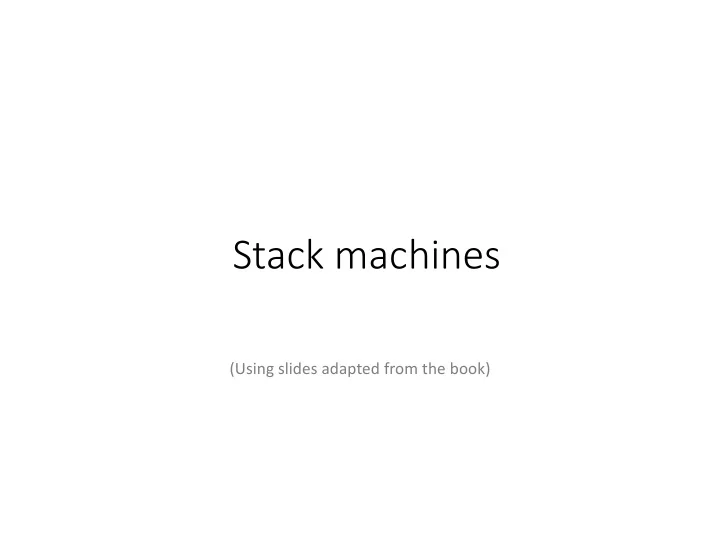

Stack machines (Using slides adapted from the book)
Stacks • A stack machine maintains an unbounded stack of symbols • We'll represent these stacks as strings • Left end of the string is the top of the stack • For example, abc is a stack with a on top and c on the bottom Popping abc gives you the symbol a , leaving bc on the stack • Pushing b onto abc produces the stack babc •
Stack Machine Moves • A stack machine is an automaton for defining languages, but unlike DFA and NFA: no states! • It is specified by a table that shows the moves it is allowed to make. For example: • Meaning: • If the current input symbol is a , and • if the symbol on top of the stack is c , it may make this move: • pop off the c , push abc , and advance to the next input symbol
Leaving The Stack Unchanged • Every move pops one symbol off, then pushes a string of zero or more symbols on • To specify a move that leaves the stack unchanged, you can explicitly push the popped symbol back on: • Meaning: • If the current input symbol is a , and • if the symbol on top of the stack is c , it may make this move: • pop off the c , push it back on, and advance to the next input symbol
Popping The Stack • Every move pushes a string onto the stack • To specify a move that pops but does not push, you can explicitly push the empty string: • Meaning: • If the current input symbol is a , and • if the symbol on top of the stack is c , it may make this move: • pop off the c , push nothing in its place, and advance to the next input symbol
Moves On No Input • The first column can be ε • Like a ε -transition in an NFA, this specifies a move that is made without reading an input symbol • Meaning: • Regardless of what the next input symbol (if any) is, • if the symbol on top of the stack is c , it may make this move: • pop off the c , and push ab in its place
Stack Machines • A stack machine starts with a stack that contains just one symbol, the start symbol S • On each move it can alter its stack, but only in stack order • Can be non-deterministic • A string is in the language if there is at least one sequence of legal moves that reads the entire input string and ends with the stack empty
Example • Consider input a (and, as always, initial stack S ): • Three possible sequences of moves • Move 1 first: no input is read and the stack becomes ab ; then stuck, rejecting since input not finished and stack not empty • Move 2 first: a is read and the stack becomes ef ; rejecting since stack not empty • Move 3 first: a is read and the stack becomes empty; accepting
Strategy For { a n b n } We'll make a stack machine for language { a n b n } • As always, the stack starts with S • Reading the input string from left to right: • • For each a read, pop off the S , push a 1, then push the S back on top • In the middle of the string, pop off the S ; at this point the stack contains just a list of zero or more 1s, one for each a that was read • For each b read, pop a 1 off the stack
Stack Machine For { a n b n } That strategy again: • 1. For each a you read, pop off the S , push a 1, then push the S back on top 2. In the middle of the string, pop off the S ; at this point the stack contains just a list of zero or more 1s, one for each a that was read 3. For each b you read, pop a 1 off the stack
Strategy For { xx R } Reading the input string from left to right: • • For each a you read, pop off the S , push a , then push the S back on top • For each b you read, pop off the S , push b , then push the S back on top • In the middle of the string, pop off the S ; at this point the stack contains just a sequence of a s and b s, the reverse of the input string read so far • For each a you read, pop a off the stack • For each b you read, pop b off the stack
Stack Machine For { xx R } That strategy again: • 1. For each a you read, pop off the S , push a , then push the S back on top 2. For each b you read, pop off the S , push b , then push the S back on top 3. In the middle of the string, pop off the S ; at this point the stack contains just a sequence of a s and b s, the reverse of the input string read so far 4. For each a you read, pop a off the stack 5. For each b you read, pop b off the stack
Recommend
More recommend